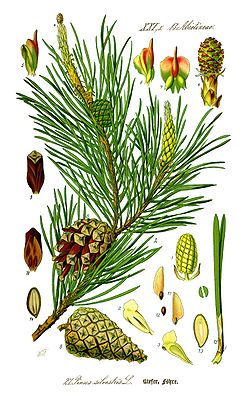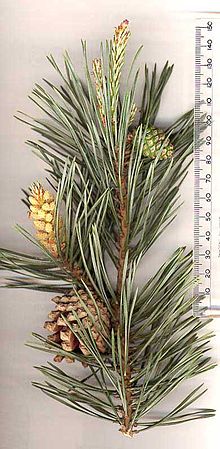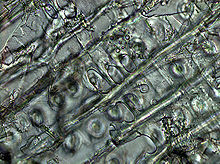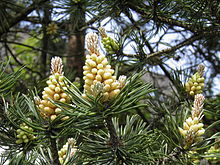Scots pine
| Forest pine | ||||||||||||
|---|---|---|---|---|---|---|---|---|---|---|---|---|

Forest pine ( Pinus sylvestris ), illustration |
||||||||||||
| Systematics | ||||||||||||
|
||||||||||||
| Scientific name | ||||||||||||
| Pinus sylvestris | ||||||||||||
| L. |
The Scots pine ( Pinus sylvestris ), also called common or common pine , red pine , white pine or forche , is a species of the pine genus ( Pinus ) from the pine family (Pinaceae). To emphasize their belonging to the genus of the pine, the hyphen spelling forest pine is widespread in botany .
The Scots pine is one of the most commonly cultivated tree species in Germany for forestry and timber industry reasons. Natural pine forests are also much less common .
description

Habitus
The Scots pine is a fast-growing evergreen conifer . It can reach top heights of up to 48 m and trunk diameters of up to 1 m. Their achievable age is approx. 600 years.
The Scots pine is very variable in growth form. Depending on the location, there are narrow, conical or broad umbrella-shaped crowns. The branch floors are loosely built. Older trees often have a hemispherical crown and a solid, long trunk with the lower branches dead. The Scots pine forms an expansive canopy on locations with little substrate , on a rocky surface or as a wind escape on coasts.
bark
The bark is smooth gray-yellow when young. Later, brown-red, deeply cracked and coarse scales form in the lower trunk area, and the orange, thin mirror bark in the upper trunk area. The trunks of the older Scots pine are clearly two-colored. Shiny plates that are thin like parchment are often detached from the mirror bark.
Needles
The perennial needles are more or less twisted, grouped in pairs in a needle sheath (short shoot) and are 4 to 7 cm long. Their color is blue-green. The needles are usually rigid and pointed, but often softer in the shaded crown area. Histologically there are two resin canals that accompany the central cylinder with the two vascular bundles running through it . As with leaves, ventilation and evaporation are regulated by small pores, the so-called stomata . Except for seedlings, there are only two needles on short shoots. When young, they are protected by membranous lower leaves .
blossoms
The male flowers emerge in large numbers around the base of the youngest long shoots . When immature, they are initially spherical to ovoid and green-yellow. They are Aufgeblüht about two centimeters long, are cylindrical and reddish brown to brown with yellow pollen . At the end of the short shoots there are one to three female flowers. These are reddish and about 5 to 8 inches long. In the female flowers, the seeds are formed after pollination and fertilization . The stalks of the female cones bend towards the branch after fertilization. Flowering time is from April to May. The pollen is spread by the wind. The fertilized female cones are initially dark green and do not ripen until November of the second year. The ripe, dark gray-brown, cone-shaped cones are up to 8 inches long and 3.5 inches wide. They sit in pairs or in groups on curved stems. Upon release of the winged seeds, which are spread by the wind, these cones fall off as a whole.
Chromosome number
The number of chromosomes is 2n = 24.
photos
ecology
The needle tips act as condensation points, which means that they promote the formation of dew and thus serve to obtain additional water. The needles fall off together with the associated short shoot . Usually this happens after 3 years, in areas with high air pollution even in the second year. In addition, the needles stay shorter when the air is polluted.
The needles show pronounced drought adaptations, especially against frost drought . The strongly thickened cell walls of the epidermis and hypodermis make them leathery and coarse (scleromorphism). The stomata are sunk to protect against perspiration. In part, this is also to be understood as an adaptation to nutrient-poor soils ( peinomorphosis ).
All branches and the terminal shoot are extended annually by a long shoot. By counting the number of knuckles, it is easy to estimate the age.
The tap root reaches 6 meters deep. The fine roots form ectomycorrhizae, for example with toadstool , irritant species and buttercups .
The Scots pine is wind-flowered (immobile type). The pollen has air sacs and can fly several kilometers. The flowers are monoecious and vormännlich . The male flowers are clustered in clusters in the lower half of this year's long shoots. Stamens are numerous, spirally arranged, each reduced to two pollen sacs. Because of the abundant pollen production, the phenomenon of "sulfur rain" often occurs during the main flowering period. Even in big cities like Berlin you can find large areas of yellow, dusty precipitation, especially on rain puddles. Regardless of the wind flowering, the pine pollen is an important source of food for bees . The red female inflorescences (= cones) are laterally at the tip of long shoots. They consist of numerous, spirally arranged cover scales and each one seed scale with two ovules directed towards the axis in their armpits.
After pollination , the pollen tube grows very slowly, so that fertilization does not take place until the following year in the now somewhat grown, still green and completely closed cones.
The Scots pine can flower from around 10 to 15 years. It causes hay fever in some people .
The seeds ripen in the autumn of the 2nd year and are only released from the cones in the spring of the 3rd year. The seed scales are then lignified and have overgrown the cover scales. The well-known opening and closing of the pine cones as a weather prophet is based on hygroscopic movements and thus indicates different weather conditions: In damp weather, the bottom (= outside) of the seed scales swells more than the top, and the cone closes. When it is dry, the cones spread and release the winged seeds. The process can be traced in the experiment: dry cones immersed in water close after approx. 2 hours.
The seeds are spread by the wind as a rotary flyer . They are available in two forms: the short-winged form has a minimum flight range of 150 meters, the long-winged one of approx. 1000 meters. In addition, there is a spread of processing by woodpeckers and squirrels as well as the spread of water adhesion. The seeds store fatty oil. They are light germs . The seedling has four to seven cotyledons .


Occurrence
distribution
The main distribution area includes Europe as far as Siberia . It extends in the north to Lapland , in the south to the extreme northwest of Spain , the north of Portugal and Turkey (Nordic-Eurasian-continental area). In Western Europe ( France and Scotland ) it is to be found scattered, in the southern parts of the area almost exclusively relict occurrences in the mountains, which have often been described as separate subspecies (or local varieties) ( catalaunica , cretacea , iberica , nevadensis , pyrenaica , rhodopea and romanica ) .
In Germany the Scots pine would naturally be a rather rare tree species, which, due to its low competitive strength compared to other, shade-friendly tree species, would only be limited to marginal yield locations. The Scots pine naturally dominates under Central European climate conditions only in particularly nutrient-poor and dry or wet locations such as, for example, on wooded sand dunes or in forests at the edge of the bog . Since the Scots pine is very robust in its youth and still delivers good timber yields even under difficult conditions, it has been grown extensively by German forest owners and foresters for centuries. Today, after the common spruce , it is the second most common tree species in German forests . With 2.4 million hectares, the pines grow on 22.9 percent of the German forest area. In the course of the forest conversion , however, pure pine stands have been converted back into local mixed forests for several decades . The pine area in Germany decreased by 85,000 hectares between 2002 and 2012. In Germany, the Scots pine is mainly found in Brandenburg , Saxony-Anhalt , Mecklenburg-Western Pomerania and Lower Saxony as well as in the northern parts of Saxony and Bavaria .
Location
The Scots pine is an undemanding tree species and tolerant of many soils and climates. With its taproot system, it can also penetrate deeper layers of water. Pine forests naturally grow on poor, dry soils on sandy and boggy locations as well as on dry limestone soils, since the assertiveness of other tree species is weakened here. Its pointer value for the leanest forest locations is, however, of no significance, since it was moved by humans to better locations and is there to create a population. Natural pine forests occur mainly under subcontinental climatic conditions and avoid the Atlantic west of Europe. According to Oberdorfer , the Scots pine is naturally predominant in societies of the Dicrano-Pinion, Cytiso-Pinion or Erico-Pinion associations.
Researchers have found that the Scots pine changed its genetic make-up after the Chernobyl disaster through increased DNA methylation and thus adapted to the consequences of ionizing radiation.
The Engadine Scots Pine
Scots pines with slightly different characteristics occur in the Alpine region, known as Engadine Scots Pine ( Pinus sylvestris L. subsp. Engadinensis (Heer) Asch. & Graebn. ). Isolated finds of correspondingly classified individuals are also available from the Bavarian Alps. Other authors consider the clan only as a variety of Scots pine, in isolated cases also as a real species. The Engadin Scots pine is obviously hybridized with the related mountain pine ( Pinus mugo ) and (possibly stabilized) backcrossing swarms with the Scots pine, i.e. a hybridogenic clan. It has recently been discussed that the Engadin Scots pine could be a direct (primary) hybrid between the species. The Engadine Scots Pine occurs particularly in pre-alpine and alpine societies of the Erico-Pinion association.
Differentiation from similar species
When determining the Scots pine, a superficial examination can lead to confusion with the black pine . The species differ in their habitus . Since the two types of tree also have different needle rotation, it is relatively easy to tell them apart. In the Scots pine, the two needles on the short shoot cannot be combined into "one needle", whereas this is possible without any problems with the Black Pine. The black pine does not form mirror bark in the upper trunk area ; the color of the bark is different. The cones are very different in color and size; the needles are also of different sizes.
Forest pests
Many insect species living on the Scots pine are still considered pests from a forestry point of view in Central Europe. Although it corresponds to the fact that the increased occurrence of some species in some years can lead to economic losses in forestry, it should be even more than before, especially in view of the threatening decline in species in recent years, a look at the ecological connections are established. Many insect species that were considered forest pests just a few years ago have become so rare in Germany and many other European countries that they had to be placed under strict species protection. Others are already missing or extinct. In the following some species are described that depend on the Scots pine as a food crop.
Importance as a fodder plant (selection)
Butterflies
- Forleule ( Panolis flammea )
- Pine resin gall moth ( Eudonia delunella )
- Pine hawk ( Hyloicus pinastri )
- Pine moth ( Bupalus piniaria )
- Pine moth ( Dendrolimus pini )
- Monastery woman ( Panthea coenobita )
- Softwood bark spider ( Peribatodes secundaria )
- Nun ( Lymantria monacha )
- Pine processionary moth ( Thaumetopoea pityocampa )
Beetle
- Blue pine jewel beetle ( Phaenops cyanea )
- Great forest gardener ( Tomicus piniperda )
- Little Forest Gardener ( Tomicus minor )
- Pine weevil ( Pissodes spec. )
- Six-toothed pine bark beetle ( Ips acuminatus )
Hymenoptera
- Common pine sawfly ( Diprion pini )
Diseases
The pine chute is the most important pine disease. Mainly young trees and pine cultures are affected. The trigger is the harmful fungus Lophodermium seditiosum .
The Diplodia shoot death is caused by the harmful fungus Sphaeropsis sapinea . It attacks the young shoots during budding and causes them to die off. Since 2017, the disease has been a problem in large areas in Germany, because the constantly warmer summers combined with severe drought have weakened the trees and made them susceptible to the fungus.
The pine bark blister rust , a through rusts widespread in Europe pine disease, the cause is that when old pine trees, the upper portion of the crown above the infested cattle area dies and as a dry plait from the green crown protrudes (Zopftrocknis). Because of the strong resinification of the bark area and also of the wood in the infested area (kiening), this disease is also called Kienopf .
The dwindling shoots are caused by the harmful fungus Cenangium ferruginosum , which is widespread in Central Europe and mainly inhabits the Scots pine.
The European Union is currently making significant efforts to prevent the introduction of the pine wood nematode ( Bursaphelenchus xylophilus ). The species native to North America is distributed through the timber trade and packaging timber . The Scots pine is extremely sensitive to the pest, so there is a risk of enormous damage. The species has already been introduced to Portugal . Since the beginning of 2010 z. B. all Euro pallets are treated to stop the spread.
use
Forest management
In Europe, Scots pines are often cultivated in plantation-like monocultures to meet the high demand for construction and industrial timber. On better sites these stocks can later deciduous species underpinned be, whereby the holdings indoor climate improved significantly. Pure pine stands are generally used in clear cutting after the economic objective has been achieved .
Since the operation form of clear-cutting economy with the regular sequence of softwood pure stocks in the past as little stable to the increasing biotic and abiotic has loads proved that pine stands in central Europe are often in today on harvested method used. Deciduous trees are then planted under the remaining loose umbrella, which will later form the subsequent forest. Natural regeneration of the pine trees is also possible on poor locations .
resin
Pines produce resin , which forms the wound closure when the bark is damaged and protects the tree from infection with fungal diseases. From the resin of the pine, the raw balsam, turpentine oil and rosin can be obtained by distillation . Resin extraction ( bad luck ) is no longer common in Germany today. There are still resin processing companies in Austria.
Wood
In forestry , Scots pines are harvested after a growth period ( rotation period ) of 80 to 140 years or after reaching a certain thickness (approx. 35 or 40 centimeters diameter at breast height ).
Scots pines provide an important timber and are used as construction timber (also in the form of solid structural timber and glued laminated timber ), as garden timber (usually pressure-impregnated ), for furniture , solid wood and plane boards, profiled wood, strips, etc.
In the standard used in Europe for commercial timbers ( DIN EN 13556 ), the Scots pine has the abbreviation PNSY.
Other products
Some products made from pine components are said to have medicinal properties.
Pine needle oil ( Oleum pini silvestris ) is the essential oil distilled from fresh needles or twig tips. It is mainly used as an expectorant for bronchitis. There is u. a. from pinene , but its typical smell comes from the high content of bornyl acetate .
Turpentine oil is skin-irritating and antiseptic and is therefore used for rubbing in rheumatic diseases. With prolonged exposure, however, painful skin inflammation occurs, as well as ulcer changes and profound tissue damage. The delta-3-carene is particularly responsible for this. Bronchospasm can also be increased. Turpentine oil consists of pinene , camphene , β-phellandrene , δ-3-carene and limonene as the main ingredients.
Pine bark extracts contain anti-inflammatory substances that, for. B. could be used against arthritis.
Real pine honey goes back to the excretions of scale and bark lice that suck on the needles ( honeydew forest costume). A large pine tree can produce several kilograms of honey per year.
So-called Kienspan , which was previously used as a light source in mines, can be extracted from the caked wood .

Others

A Scots pine grows on a shield wall of the ruins of Auerbach Castle in the Odenwald, and it is rooted alone on the structure at a dizzy height. Despite the very poor living conditions, it has reached an age of more than 300 years and a height of seven meters - impressive evidence of the pronounced modesty of the plant.
Scots pines are popular as Christmas trees in European countries , but are rarely used for them in Germany. They keep their needles well into January, but are a little harder to decorate than other conifers.
The Scots pine was tree of the year in 2007.
literature
- Manfred A. Fischer , Wolfgang Adler, Karl Oswald: Excursion flora for Austria, Liechtenstein and South Tyrol. 2nd, improved and enlarged edition. State of Upper Austria, Biology Center of the Upper Austrian State Museums, Linz 2005, ISBN 3-85474-140-5 .
- Mayer, Bachhofer: The new cosmos tree guide. Kosmos, Stuttgart, 2006, ISBN 978-3-440-10217-6 .
- Burghard von Lüpke (Hrsg.): Silvicultural questions of the pine industry. Colloquium on the occasion of the 100th birthday of Adolf Olberg, Göttingen 1994. Writings from the Forestry Faculty of the University of Göttingen and the Lower Saxony Forest Research Institute, Volume 119. Sauerländer, Frankfurt am Main 1995, ISBN 978-3-7939-5119-3 .
- Gottfried Amann : Trees and bushes of the forest. 20th edition, Neumann-Neudamm, 2011, ISBN 978-3-7888-0758-0 .
- Andreas Roloff : The Scots Pine , Tree of the Year 2007. Green information sheet from the Kuratorium Tree of the Year - see www.baum-des-jahres.de.
- Silvius Wodarz : Forest - Pine, Tree of the Year 2007. Yellow, child-friendly information sheet from the Board of Trustees “Tree of the Year” - see www.baum-des-jahres.de.
- Heiko Bellmann : The new Kosmos butterfly guide. Butterflies, caterpillars and forage plants. 2nd Edition. Franckh-Kosmos, Stuttgart 2009, ISBN 978-3-440-11965-5 .
Web links
- Scots pine. In: FloraWeb.de.
- Scots pine . In: BiolFlor, the database of biological-ecological characteristics of the flora of Germany.
- Profile and distribution map for Bavaria . In: Botanical Information Hub of Bavaria .
- Distribution in Switzerland In: Info Flora , the national data and information center for Swiss flora .
- Distribution in the northern hemisphere according to Eric Hultén
- Thomas Meyer: Data sheet with identification key and photos at Flora-de: Flora von Deutschland (old name of the website: Flowers in Swabia )
- Baumkunde.de
- Wald.de
- Tree species atlas Austria, white pine
- Wood
- Description and systematics of the species on conifers.org, (English)
- Pinus sylvestris in the endangered Red List species the IUCN 2006. Posted by: Conifer Specialist Group, 1998. Retrieved on 12 May, 2006.
- Tree of the year 2007
Individual evidence
- ↑ Friedrich Markgraf (Ed.): Illustrated flora of Central Europe. Pteridophyta, Spermatophyta . Founded by Gustav Hegi. 3rd, completely revised edition. Volume I. Part 2: Gymnospermae, Angiospermae: Monocotyledoneae 1 (Alismataceae - Scheuchzeriaceae) . Paul Parey, Berlin / Hamburg 1981, ISBN 3-489-51020-8 , pp. 87-98 .
- ↑ a b c Erich Oberdorfer : Plant-sociological excursion flora for Germany and neighboring areas . With the collaboration of Angelika Schwabe and Theo Müller. 8th, heavily revised and expanded edition. Eugen Ulmer, Stuttgart (Hohenheim) 2001, ISBN 3-8001-3131-5 , pp. 93-94 .
- ↑ National Forest Inventory 3, 2012 . Retrieved December 2, 2015.
- ↑ Olga Kovalchuk, Paula Burke, Andrey Arkhipov, Nikolaj Kuchma, S. Jill James, Igor Kovalchuk, Igor Pogribny: Genome hypermethylation in Pinus silvestris of Chernobyl — a mechanism for radiation adaptation? In: Mutation Research / Fundamental and Molecular Mechanisms of Mutagenesis. 529 (1-2), 2003: 13-20. doi : 10.1016 / S0027-5107 (03) 00103-9 .
- ↑ Reiner Finkeldey, Barbara Vornam, Oleksandra Kuchma: Genetic reactions to extreme environmental change using the example of pines in Chernobyl (Genetic reactions to extreme environmental change: Pines in Chernobyl as an example). In: Forest Archive. 83/2012, 41-47, doi : 10.4432 / 0300-4112-83-41 .
- ↑ Knud Ib Christensen & Ghulam Hassan Dar: A morphometric analysis of spontaneous and artificial hybrids of Pinus mugo x sylvestris (Pinaceae). In: Nordic Journal of Botany. 17 (1), 1997: 77-86 (Copenhagen), doi : 10.1111 / j.1756-1051.1997.tb00291.x .
- ↑ Stadtwald in Quedlinburg The pines are dying at mz-web.de, accessed on November 5, 2019.
- ↑ What's wrong with the jaw? at aelf-wb.bayern.de, accessed on November 5, 2019.
- ↑ http://www.waldwissen.net/waldwirtschaft/nebennutzen/produkte/bfw_harzutzen/index_DE
- ↑ Scots pine at www.baum-des-jahres.de Baum des Jahres.de











